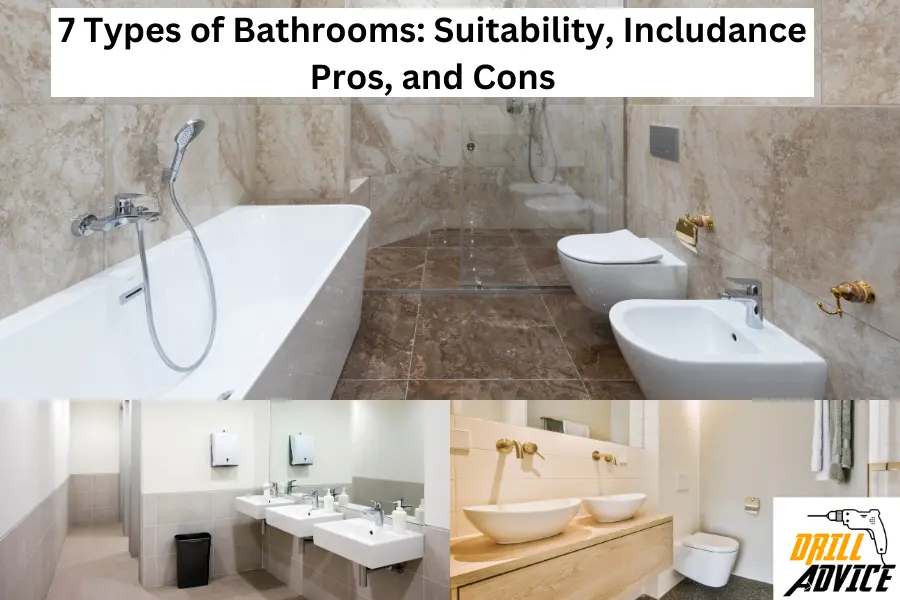
The bathroom is an essential place for the living area. The bathroom types are varied with the available fixtures in the bathroom. A bathroom needs 4 essential equipment such a toilet, sink, shower and bathtub. Bathrooms can be categorized into 7 main types according to the availability of the above equipment.
The 7 types of bathrooms are full bathroom, three-quarter bathroom, half bathroom, ensuite bathroom, Jack and Jill’s bathroom, commercial bathroom and outdoor bathroom.
When you choose a bathroom type, consider its suitability for the user, purpose and place. Users can be guests, clients, employers or family members. The main 3 purpose of using the bathroom is bathing, washing, and peeing. The places can be the home, workshop, outdoor, and office. You should consider all of the factors before you choose a suitable bathroom.
Each bathroom type includes equipment (fixtures). According to the user requirement, fixtures should be included in the bathroom. All of these types have both pros and cons. When you choose, you should choose the best type always.
1. Full Bathroom
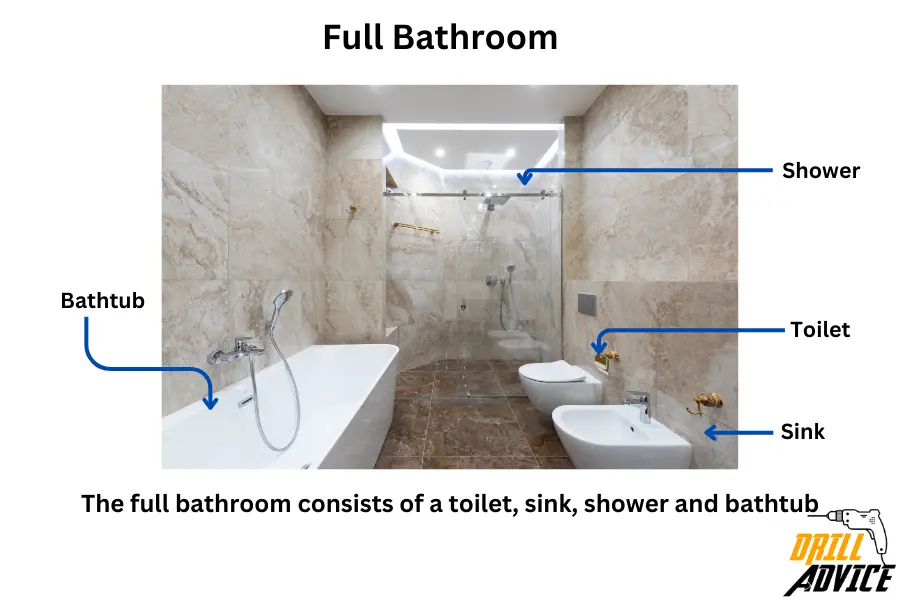
A full bathroom includes all the essential equipment for personal hygiene and bathing. It provides all the amenities, including a toilet, sink, shower, and bathtub, allowing individuals to perform various personal care activities within the same space.
Full bathrooms are typically found in residential homes. They are attached to bedrooms, common living areas, or hallways, ensuring easy access for occupants and guests.
Full bathrooms are suitable for individuals or families who require a complete set of bathing and hygiene facilities in one space. They are commonly used by residents for daily personal care activities, including showering, bathing, and toileting.
Included in the Full Bathroom
- Sink
- Toilet
- Bathtub
- Shower
Read More About
- Recommended Dimensions for Bathroom Toilet, Sink, Shower and Bathtub
- 9 Best Bathroom Shower Types: Pros, Cons, Size and Considerable Factors
Advantages of Full Bathroom
- Consists with essential fixtures: A full bathroom provides all the essential fixtures needed for personal hygiene and bathing in one convenient location.
- Increased Property Value: Homes with full bathrooms, especially multiple ones, are often more attractive to potential buyers and can contribute to a higher resale value.
- Functional Design: Full bathrooms offer a dedicated space for all personal hygiene activities, helping to keep other areas of the house cleaner.
Disadvantages of Full Bathroom
- Require More Space: Full bathrooms occupy more space compared to smaller bathroom types, which might be a limitation in smaller homes or spaces.
- Frequently Cleaning and Maintenance: Having additional fixtures means potentially more maintenance and cleaning work, especially for the bathtub and shower areas.
- Expensive: Larger bathrooms need more material and labour. Hence full bathrooms are expensive construction.
2. Three-Quarter Bathroom

A three-quarter bathroom is a type of bathroom commonly found in residential homes. It includes a sink, a toilet, and a shower. This bathroom type is designed to provide basic personal hygiene facilities without including a bathtub.
This type of bathroom is suitable for quick showers and regular use for personal hygiene. It is often located near common areas of the house to accommodate guests or occupants of adjacent rooms. The three-quarter bathroom is usually attached to a bedroom, hallway, or common living area.
The three-quarter bathroom is suitable for individuals or couples who prioritize functionality and space efficiency over the luxury of a bathtub.
Included in the Three-Quarter Bathroom
- Sink
- Toilet
- Shower
Not Included in the Three-Quarter Bathroom
- Bathtub
Advantages of Three-Quarter Bathroom
- Use Space Efficiently: Three-quarter bathrooms are smaller rooms or areas where a full bathroom can not be used.
- Suitable for Essential Functionality: Provides essential personal hygiene facilities for everyday use.
- Guest-Friendly: Convenient for guests or visitors in the home.
Disadvantages of Three-Quarter Bathroom
- Resale Value: In some real estate markets, a three-quarter bathroom might be perceived as having less value compared to a full bathroom with a bathtub.
- Limited Relaxation: The lack of a bathtub might make it less suitable for those who enjoy long, relaxing baths.
3. Half-Bathroom
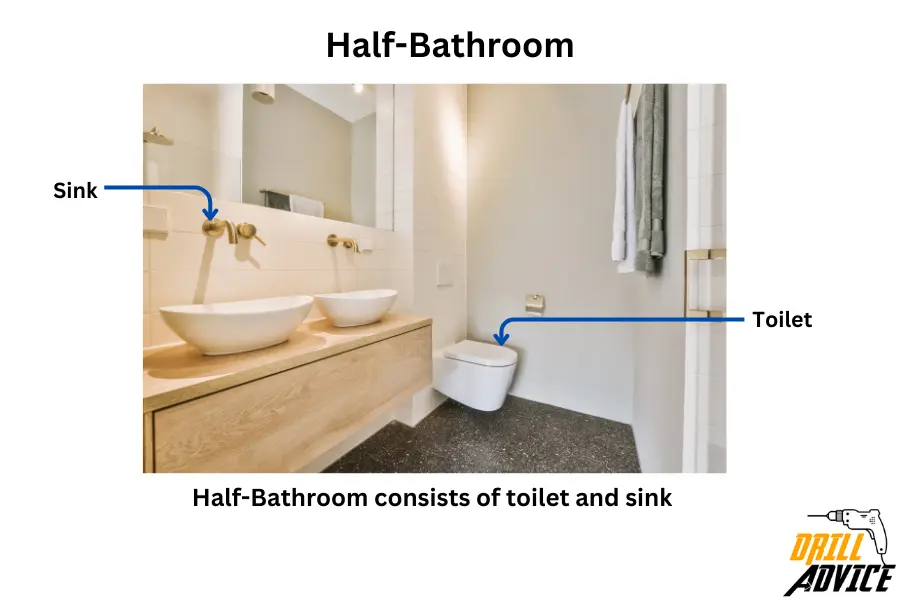
A half-bathroom, commonly known as a half bath or powder room, is a smaller type of bathroom found in residential homes. A half-bathroom typically contains only essential fixtures for basic hygiene and convenience. It includes a sink and a toilet, but it does not have a shower or bathtub. Half-bathrooms are designed to serve guests and occupants for quick bathroom needs without the need for a full bathing facility.
Half-bathrooms are often strategically placed near common areas of the house, such as the living room or dining area, to provide easy access for guests. They are also commonly located on the main floor of a home.
Half-bathrooms are suitable for homeowners who want to provide a guest bathroom or for properties where space is limited. They are especially useful for accommodating guests during social gatherings and events, allowing them to freshen up without needing to access private areas of the house.
Included in the Half Bathroom
- Sink
- Toilet
Not Included in the Half Bathroom
- Shower
- Bathtub
Advantages of Half Bathroom
- Consume Less Space: Half-bathrooms take less space compared to full bathrooms.
- Guest Convenience: They provide a dedicated space for guests to use the restroom without needing to access private areas of the house.
- Value Addition: Having a half-bathroom can enhance the overall functionality and appeal of a home, potentially increasing its value.
Disadvantages of Half Bathroom
- Limited Facilities: Half-bathrooms cannot be used for bathing, which might be inconvenient for some situations.
- Reduced Functionality: Half-bathrooms are designed for quick visits and are not suitable for extended use or personal hygiene routines that require bathing.
4. Ensuite Bathroom
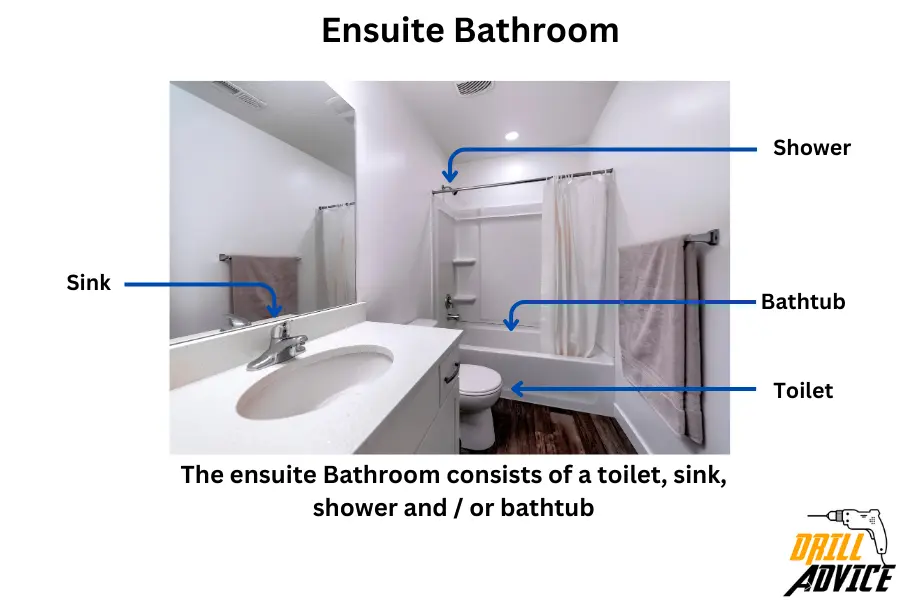
An ensuite bathroom is a type of bathroom that is directly connected to and accessible from a bedroom. It is considered a private bathroom that serves a specific bedroom. Ensuite bathrooms are often designed to offer a more personal and comfortable bathing experience for the individuals using the attached bedroom.
Ensuite bathrooms are typically attached to a master bedroom, guest bedroom, or any other bedroom in the house. They offer a level of privacy and convenience by providing occupants with their own dedicated bathroom facilities without having to share with other residents or guests.
Ensuite bathrooms are especially suitable for homeowners who prioritize personal convenience and privacy. They are commonly found in master bedrooms.
Included in the En-Suite Bathroom
- Sink
- Toilet
- Shower and/or Bathtub
Not Included in the En-Suite Bathroom
None (Ensuite bathrooms typically include all essential bathroom fixtures.)
Advantages of En-Suite Bathroom
- Consists of higher privacy: Ensuite bathrooms are connected to the bedroom. Hence it has more privacy.
- More Comfort: The close proximity of the ensuite bathroom to the bedroom enhances the comfort and convenience of daily hygiene routines.
- Enhanced Resale Value: Homes with ensuite bathrooms, particularly in master bedrooms, often have higher resale value due to the added convenience and appeal they offer.
Disadvantages of En-Suite Bathroom
- Need more space: Ensuite bathrooms require additional space within the bedroom layout, which might limit design options or impact room sizes.
- Limited Access: Ensuite bathrooms are only accessible from the specific bedroom to which they are attached, which could be inconvenient for guests or residents of other bedrooms.
- Plumbing and Maintenance: The proximity of ensuite bathrooms to bedrooms might increase the potential for noise from plumbing systems and could lead to maintenance the bedroom.
5. Jack and Jill’s Bathroom
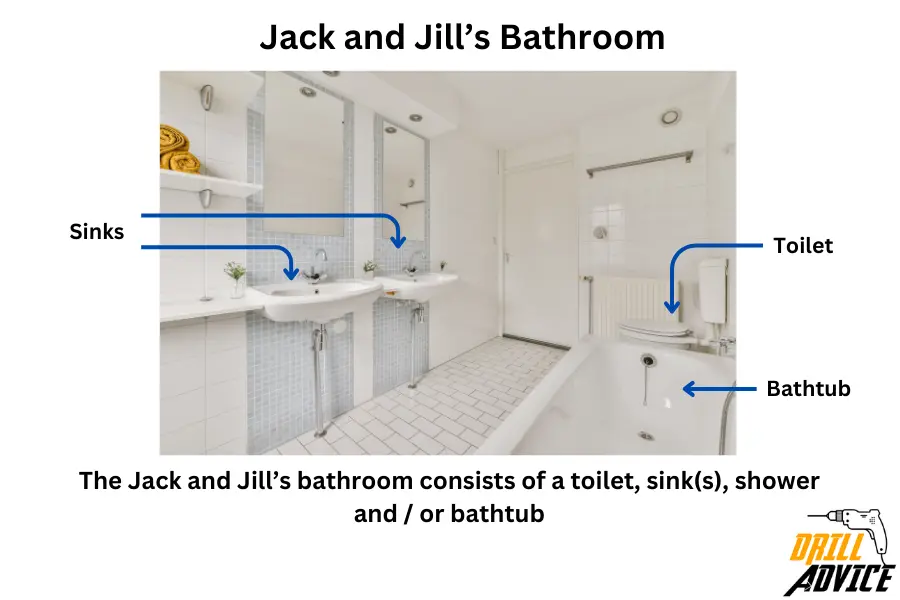
A Jack and Jill bathroom is a type of bathroom that is situated between two bedrooms and accessible from both rooms. It’s designed to be shared by occupants of the two adjoining bedrooms. It provides a convenient and efficient bathroom solution for multiple users while optimizing space utilization.
This type of bathroom setup is often used for children’s bedrooms, siblings’ bedrooms, or bedrooms in close proximity.
Jack and Jill bathrooms are well-suited for families with children or individuals who share living spaces. They provide a shared bathroom option that offers some level of privacy for each room’s occupants while promoting convenience.
Included in the Jack and Jill Bathroom
- Sink(s)
- Toilet(s)
- Shower and/or Bathtub
Not Included in the Jack and Jill Bathroom: None (Jack and Jill bathrooms typically include all essential bathroom fixtures.)
Advantages of Jack and Jill Bathroom
- Shared Convenience: Jack and Jill bathrooms offer a shared bathroom option, allowing occupants of two bedrooms to access bathroom facilities without the need for individual en suite bathrooms.
- Use Space Efficiency: By serving two bedrooms, a Jack and Jill bathroom optimizes space usage and can be more efficient than having two separate bathrooms.
- Sibling or Family Use: This setup is particularly useful for siblings or family members sharing bedrooms, as it provides a bathroom solution that’s more convenient than using a communal bathroom.
Disadvantages of Jack and Jill Bathroom
- Less privacy: User lost his complete privacy while using a shared bathroom.
- Conflict of Timing and Scheduling: Sharing a bathroom between two rooms could lead to conflicts over bathroom use, especially during busy mornings or nighttime routines.
6. Commercial Bathroom

A commercial bathroom is a restroom facility designed for use by the general public in commercial settings, such as businesses, offices, malls, airports, and public venues. It serves as a space for visitors, customers, and employees to meet their restroom needs while on the premises.
Commercial bathrooms are utilized by individuals who are present in the commercial establishment for various purposes. They are typically located within the commercial building itself and are easily accessible to visitors and employees.
Commercial bathrooms use wide range of people. Therefor it should be designed to accommodate various needs, including those of people with disabilities.
Included in the Commercial Bathroom
- Toilets and Stalls
- Sinks and Handwashing Facilities
- Hand Dryers or Paper Towel Dispensers
- Mirrors
- Soap Dispensers
- Waste Bins
- Baby Changing Stations (in some cases)
- Accessible Features (e.g., grab bars, accessible stalls)
Not Included in the Commercial Bathroom
- Bath or Shower Facilities
- Personal Care Items (e.g., towels, personal hygiene products)
- Changing Rooms (typically separate in clothing stores)
- Private Amenities (e.g., personal lockers, individual showers)
Advantages of Commercial Bathroom
- User Comfortability: Provides a necessary facility for visitors and employees.
- Increase Hygiene: Equipped with essential amenities for handwashing and sanitation to promote hygiene and reduce the spread of germs.
- Accessibility: Many commercial bathrooms are designed to be accessible to people with disabilities, enhancing inclusivity.
- Positive Customer Experience: Well-maintained and clean commercial bathrooms contribute to a positive overall impression of the establishment.
Disadvantages of Commercial Bathrooms
- Frequent Maintenance: High traffic in commercial bathrooms needs regular cleaning and maintenance to ensure cleanliness and functionality.
- Maintenance is Expensive: Designing and maintaining compliant and hygienic commercial bathrooms can be costly for businesses.
- Privacy Concerns: Balancing privacy in a communal setting is challenging with multiple users.
7. Outdoor Bathroom
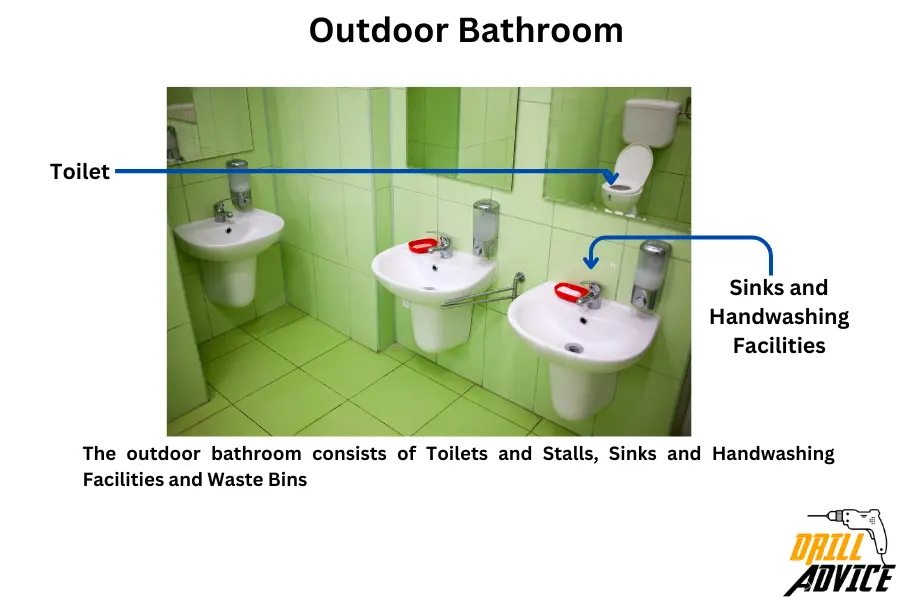
An outdoor bathroom is a restroom facility that is located outside of a building or structure. It serves a convenient and functional space for individuals who are spending time outdoors and need access to restroom facilities without having to enter the building.
Outdoor bathrooms are commonly found in various outdoor environments such as parks, campgrounds, beaches, and recreational areas.
Outdoor bathrooms are suitable for individuals who are participating in outdoor activities, events, or gatherings. Outdoor bathroom is suitable for park visitors, campers, beachgoers, hikers, and attendees of outdoor events.
Included in the Bathroom:
- Toilets
- Handwashing Facilities (e.g., sinks, hand sanitizers)
- Waste Bins (for disposal of waste items)
Not Included in the Bathroom:
- Showers (unless specified in certain camping or beach facilities)
- Bathtubs
- Additional Indoor Amenities
Advantages:
- Convenience: Provides a necessary facility for individuals engaged in outdoor activities.
- Accessibility: Outdoor bathrooms enhance accessibility for people who are not near indoor facilities.
- Hygiene: Equipped with amenities for handwashing and sanitation, contributing to personal hygiene and reducing the spread of germs.
Disadvantages:
- Exposure to Elements: Outdoor bathrooms are subject to weather conditions, which might make their use uncomfortable during extreme temperatures or inclement weather.
- Maintenance Challenges: Maintaining outdoor bathrooms can be more challenging due to exposure to the elements, requiring regular cleaning and upkeep.
- Limited Amenities: Outdoor bathrooms typically provide only basic amenities and might lack certain comforts available in indoor facilities.
What are the Common Problems in the Bathroom?
These are the common 7 bathroom problems.
- Clogged drains: One of the most common bathroom problems is clogged drains. This issue usually occurs in the shower or bathtub and is often caused by hair, soap residue, and other debris that get washed down the drain.
- Leaky faucets: A dripping faucet can be a major annoyance and can lead to significant water waste if not addressed promptly. This issue is typically due to worn-out components, such as the washer or the valve seat.
- Poor ventilation: Bathrooms need good ventilation to prevent the buildup of moisture, which can lead to mold and mildew growth. A lack of proper ventilation can also cause paint or wallpaper to peel.
- Toilet problems: From constant running to clogging, toilets can present a number of issues. These problems can often be traced back to issues with the flapper, fill valve, or clog in the drain pipe.
- Insufficient lighting: Good lighting is essential in a bathroom for tasks like applying makeup or shaving. Poor or insufficient lighting can make these tasks difficult and can also make the bathroom look dull and uninviting.
- Lack of storage space: Many bathrooms, especially in older homes or apartments, lack sufficient storage space. This can lead to cluttered countertops and difficulties in organizing toiletries and other bathroom essentials.
- Outdated fixtures and finishes: Outdated fixtures and finishes can not only make a bathroom look dated, but they can also lead to functional issues. For example, old pipes can corrode and lead to leaks, and outdated electrical outlets may not be up to current safety standards.
Read More About – 7 Ways Remove Bathroom Odor: Reasons, Effects, Removers, and Maintenance
What Bathroom Flooring Types are the Best?
These are 10 best types of bathroom floorings.
- Natural Stone Flooring
- Ceramic and Porcelain Tiles
- Laminate Flooring
- Engineered Wood Flooring
- Vinyl Flooring
- Cork Flooring
- Concrete Flooring
- Rubber Flooring
- Linoleum Flooring
- Terrazzo Flooring
Read More About – 10 Best Bathroom Flooring: Water Resistance, Slippering, Cleaning, and Cost
